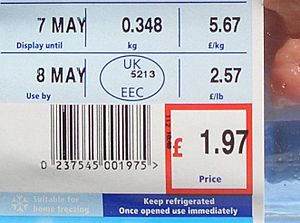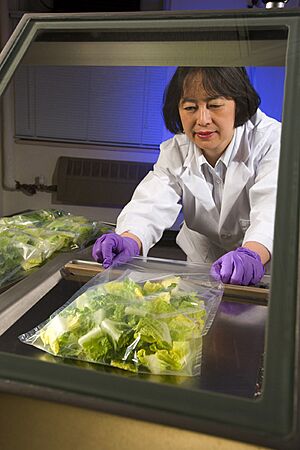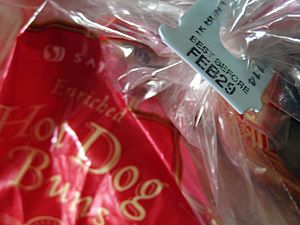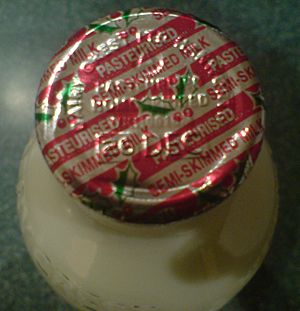Shelf life facts for kids
Shelf life is how long food, drinks, or medicines can be kept before they start to go bad. Food cannot stay good forever. After a certain time, it will spoil and might not be safe to eat. Shelf life helps us know when items are still fresh and safe.
In many countries, packaged foods must have a "best before," "use by," or "freshness date." These dates help people know how long they can store and safely use a product.
Shelf life means the time a product can be stored while keeping its quality. This is true if the product is stored correctly. For example, frozen food will spoil faster if it's not kept in a freezer. These dates are usually a guide, but they don't always guarantee safety.
Contents
Shelf Life vs. Expiration Date
Shelf life is about the quality of food. An expiration date is about safety. A product past its shelf life might still be safe to eat. However, its taste, texture, or freshness might not be as good.
Stores often use a system called stock rotation to manage shelf life. This means they move products with the earliest "sell by" dates to the front. This way, customers buy them first, and the store avoids wasting food. Stores can be fined for selling expired products. Wasted food also means a loss of money for the store.
Many things can change how long a product lasts. These include light, heat, and moisture. Even tiny living things like micro-organisms can make food spoil faster.
Shelf life is very important for your health. Bacteria are everywhere. If food is left too long, many bacteria can grow in it. Eating this food can be dangerous and lead to food poisoning. The date on the package doesn't always tell you if food is safe. For example, pasteurized milk can be good for five days after its "sell-by" date if kept cold. But if milk already has harmful bacteria, the "use-by" date doesn't matter.
For drugs, the situation is a bit different. Drug makers promise that medicines work as expected before their expiration date. After that date, they might still work, but not as well. A study by the U.S. Food and Drug Administration (FDA) looked at over 100 drugs. It found that about 90% were safe and worked well up to 15 years past their expiration date. Most expired drugs are likely still effective, except for a few like nitroglycerin or some liquid antibiotics.
Some foods and medicines have special ingredients added. These are called preservatives and antioxidants. They help make the product last longer. Companies also use special packaging methods. For example, they might use vacuum pouches to keep air out. This helps extend the shelf life of their products.
Packaging can also protect products from things that make them spoil. Many beers come in amber bottles. These bottles block light that can damage the beer. Clear beer bottles do not offer this protection. Special packaging materials can also help foods and medicines last longer.
Temperature Control and Shelf Life
Most chemical changes happen faster when it's warmer. This is why many things spoil more quickly in heat. For example, rubber products can get soft and sticky as they get old. This happens faster in warm places.
A general rule is that chemical reactions can double their speed for every 10 degrees Celsius (18 degrees Fahrenheit) increase in temperature. This means warmer temperatures make things spoil faster. This rule is often used to guess how long a product will last.
The same idea applies to living things like bacteria and fungi. They grow and multiply faster in warmer temperatures. But if it gets too hot, the heat can kill them. This is why cooking food at high temperatures makes it safe to eat.
Just as heat speeds up spoilage, cold temperatures slow it down. This is why keeping things cool makes them last longer. Refrigeration and cold chain systems help keep food and medicines fresh. This is why some items must be kept in the fridge.
Best Before Dates
A "best before" date is often found on food and drink packages. It tells you the date by which the maker suggests you eat the food. This date helps make sure customers don't buy or eat food that is no longer fresh. Sometimes, this date is printed in a less obvious spot. The package might say "best before see bottom" or "best before see lid."
"Best before" dates are usually about the quality of the product. They are different from "use by" dates. A "use by" date means the product might not be safe to eat after that date.
Use By Dates
Foods with a "use by" date should not be eaten after that date. These foods usually spoil quickly and can be dangerous if eaten when expired. It's also important to follow any storage instructions, like keeping the product refrigerated.
Foods with a "best before" date are usually safe to eat after the date. However, their taste, texture, or look might not be as good. They might also have fewer nutrients.
Bathroom products like shampoo often have a symbol that looks like an open jar. It has a number and "M" inside, like "12M." This means you should use the product within 12 months after opening it.
Open Dating
"Open dating" means a date or code is stamped on a food package. This helps stores know how long to display the product for sale. It also helps customers know the product is at its best quality. An "open date" does not replace a "use by" date. You should still follow the "use by" date for safety.
Sell By / Display Until Dates
These dates help stores manage their products. Food that has passed its "sell by" or "display until" date can still be eaten. This is true if it's within its "use by" or "best before" date and has been stored correctly. Many large stores throw away such food. This makes stock control easier and reduces the chance of customers buying old food. Changing these dates is against the law in many places.
Most stores move products with earlier dates to the front of the shelves. This helps them sell these items first. This way, the store avoids having to lower prices or throw away food, which saves them money.
Mark-downs
It's common for food that is close to its "use by" date to be sold at a lower price. The closer it gets to the date, the bigger the discount usually is. This helps stores sell the food before it expires.
US Government Guidelines
In the United States, the Food & Drug Administration (FDA) oversees packaged foods and drugs. They only require a "use by" or expiration date on infant formula and some baby foods. This is because formula must have a certain amount of nutrients. If stored too long, it loses its nutrition. It can also separate or form lumps. For most other foods, federal rules do not require dating.
The Agriculture Department (USDA) handles fresh produce and meats. They only require a date for when poultry is packed at the farm. However, many companies are allowed to add "sell by" or "use by" dates too.
Beer Freshness Dates
A "freshness date" in the American beer industry tells you when the beer was bottled. Or it tells you the date by which the beer should be enjoyed.
Beer doesn't stay good forever. It can be affected by light, air, or bacteria. Even though beer in the USA doesn't have to have a shelf life date, freshness dates are used. They help customers and are also a way for companies to market their beer.
How Freshness Dating Started
The Boston Beer Company, which makes Samuel Adams, was one of the first to add freshness dates to their beer in 1985. For ten years, more brewers slowly started using freshness dates. The idea became very popular after Anheuser-Busch started its "Born-On dates" in 1996. Many other brewers now add freshness dates. However, there isn't one standard for what the date means. For some, it's the bottling date. For others, it's the date by which the beer should be consumed.
See also
 In Spanish: Vida de anaquel para niños
In Spanish: Vida de anaquel para niños





